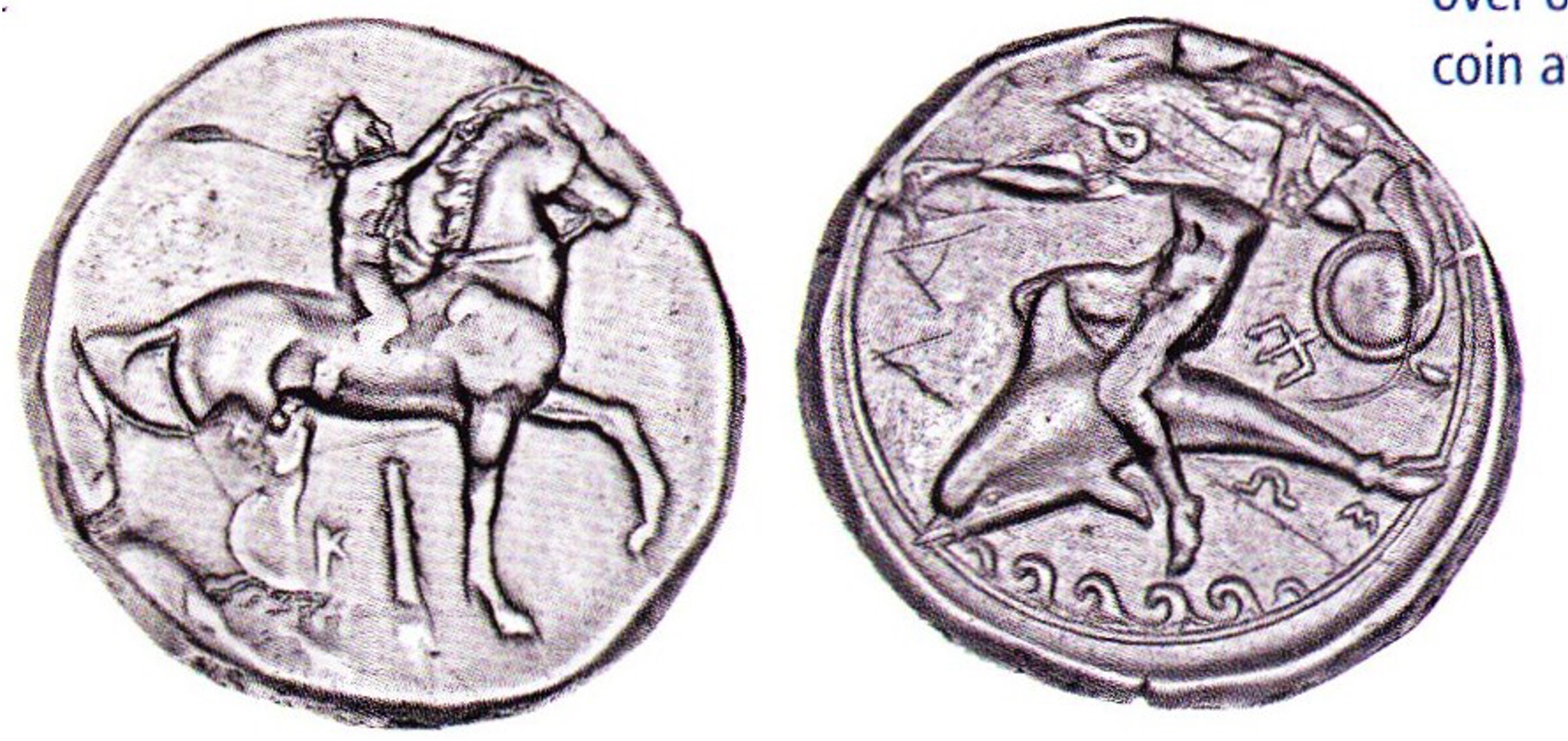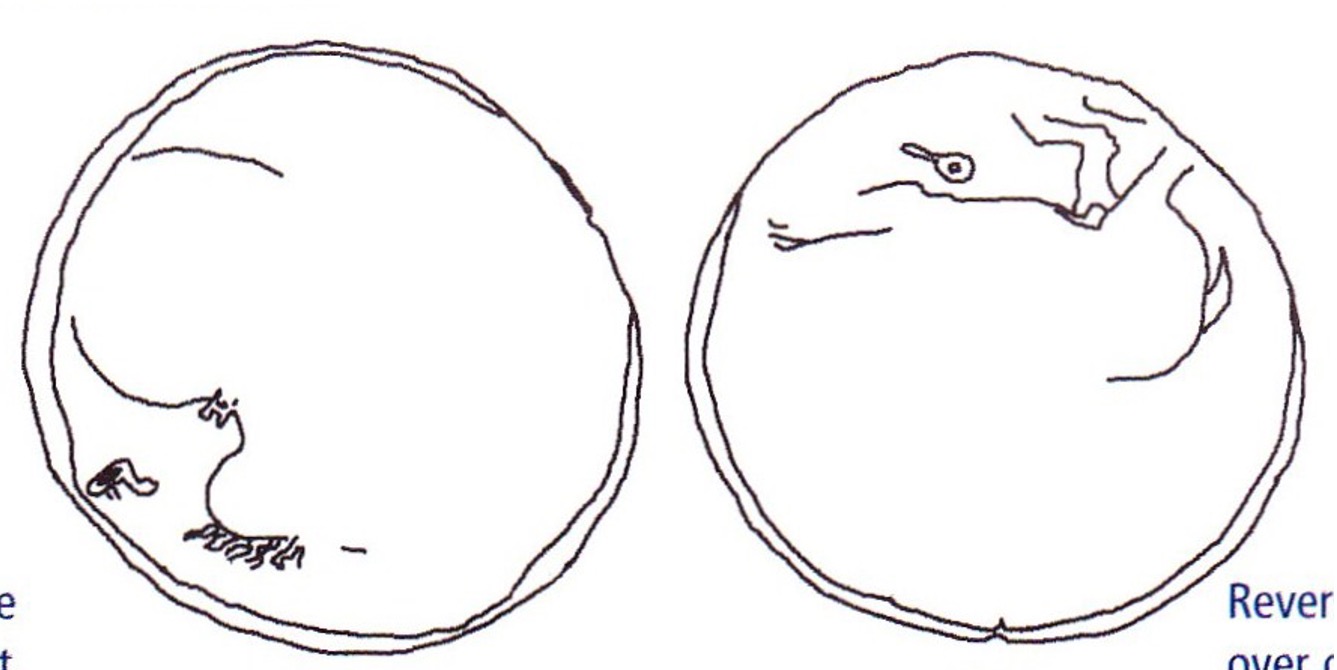344 BCE - 340 BCE | TAPAΣ
Overstriking coin
2436 - Taras (AR nomos) over Corinth.jpg
Overstruck variety
Corinth Aphrodite Pegasus right.jpeg
[1]
2436 Corinth (drawing).jpg
Description
| ObverseInscription or printing placed on the obverse.:
|
Naked youth on horse right, crowning horse. Below, K and club.
|
ReverseInscription or printing placed on the reverse.:
|
TAPAΣ (Greek) Dolphin rider left above wave pattern, right Head of Aphrodite right, hand outstretched, holding oinoche, left hand wearing Corinthian helmet. outstretched holding trident and shield. In field Before helmet, E Y or below dolphin, Ω
|
Mint and issuing power
| MintIdentifies the place of manufacture or issue of a numismatic object.:
|
Taras
|
Ancient regionAncient region.
|
Magna Graecia (Calabria)
|
Modern countryModern country: Italy
|
AuthorityIdentifies the issuing power. The authority can be "pretended" when the name or the portrait of X is on the coin but he/she was not the issuing power. It can also be "uncertain" when there is no mention of X on the coin but he/she was the issuing power according to the historical sources:
|
|
Chronology
| FromIdentifies the initial date in a range assigned in a numismatic context. 344 BCE toIdentifies the final date in a range assigned in a numismatic context.. 340 BCE
|
Classical 480-323 BC  periodTime period of the numismatic object. periodTime period of the numismatic object.
|
Physical description
MetalThe physical material (usually metal) from which an object is made.: Silver 
|
WeightWeight of the numismatic object (in grams). in grams: 7.857.85 g <br />7,850 mg <br />
|
DenominationTerm indicating the value of a numismatic object. Examples: tetradrachm, chalkous, denarius.: nomos
|
AxisDescribes the directional relationship between the obverse and reverse of a numismatic object.: 33 mm <br />0.3 cm <br />
|
|
|
|
References
Description
| ObverseInscription or printing placed on the obverse.:
|
Pegasus flying right. Below, Ϙ. Visible: Rear of Pegasus including rear legs, Ϙ.
|
ReverseInscription or printing placed on the reverse.:
|
Head of Athena right, wearing Corinthian helmet. Before helmet, E Y or E Y MA. Behind, tripod. Visible: Outline of portion of helmet and back of neck, portion of tripod.
|
Mint and issuing power
| MintIdentifies the place of manufacture or issue of a numismatic object. ᵖ:
|
Corinth
|
Ancient regionAncient region. ᵖ
|
Peloponnesus
|
Modern countryModern country: Greece
|
AuthorityIdentifies the authority in whose name (explicitly or implicitly) a numismatic object was issued. ᵖ:
|
|
Chronology
| FromIdentifies the initial date in a range assigned in a numismatic context. 360 BCE toIdentifies the final date in a range assigned in a numismatic context.. 340 BCE
|
Classical 480-323 BC  periodTime period of the numismatic object. periodTime period of the numismatic object.
|
Physical description
| DenominationTerm indicating the value of a numismatic object. Examples: tetradrachm, chalkous, denarius. ᵖ:
|
stater 
|
|
|
| AxisFrom 1 to 12 by analogy with the clock hours. ᵖ:
|
5<ul><li>No units of measurement were declared for this property.</li> <!--br--><li>"" is not declared as a valid unit of measurement for this property.</li></ul>
|
References
References
- ^ Fischer-Bossert, Wolfgang (1999), Chronologie der Didrachmenprägung von Tarent, 510-280 v. Chr., Berlin, De Gruyter, xvii, 495 p., [84] pl.
- ^ Macdonald, David (2009), Overstruck Greek coins: studies in Greek chronology and monetary theory, Whitman Publishing, Atlanta.
- ^ Calciati, Romolo (1990), Pegasi, Mortara, Edizioni I.P..
- ^ Hoover, Oliver D. (2014), Handbook of Greek Coinage Series 4. Northern and Central Greece : Achaia Phthiotis, Ainis, Magnesia, Malis, Oita, Perrhaibia, Thessaly, Akarnania, Aitolia, Lokris, Phokis, Boiotia, Euboia, Attica, Megaris and Corinthia, sixth to first centuries BC, Lancaster, lxxi, 563 p.
 Traces of the overstruck variety
Traces of the overstruck variety

